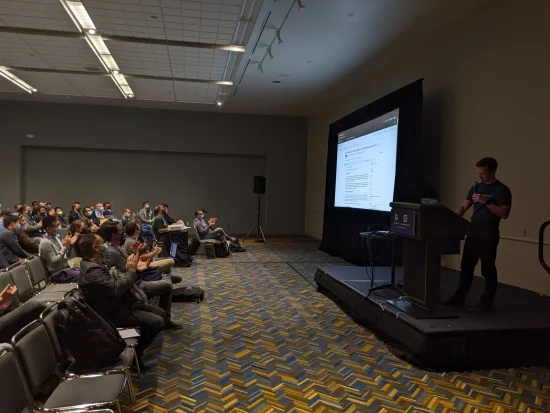Why is the kernel community replacing iptables with BPF?
Author Note: this is a post by long-time Linux kernel networking developer and creator of the Cilium project, Thomas Graf
The Linux kernel community recently announced bpfilter, which will replace the long-standing in-kernel implementation of iptables with high-performance network filtering powered by Linux BPF, all while guaranteeing a non-disruptive transition for Linux users.
From humble roots as the packet filtering capability underlying popular tools like tcpdump and Wireshark, BPF has grown into a rich framework to extend the capabilities of Linux in a highly flexible manner without sacrificing key properties like performance and safety. This powerful combination has led forward-leaning users of Linux kernel technology like Google, Facebook, and Netflix to choose BPF for use cases ranging from network security and load-balancing to performance monitoring and troubleshooting. Brendan Gregg of Netflix first called BPF Superpowers for Linux. This post will cover how these “superpowers” render long-standing kernel sub-systems like iptables redundant while simultaneous enabling new in-kernel use cases that few would have previously imagined were possible.
Having spent the past 15 years in the Linux kernel community authoring code to many subsystems including the TCP/IP stack, iptables, and many more, allowed me to observe BPF developments up close. I soon realized that BPF was not simply yet another feature but instead represented a foundational technology shift that in time would change nearly every aspect of networking and security within Linux. I started contributing and became one of its biggest supporters along side with Alexei Starovoitov and Daniel Borkmann which are now maintaining BPF upstream. In this lens, the shift from iptables with bpfilter is just the next logical step in a BPF’s journey to revitalize the Linux networking stack for the modern area. To understand why this shift is so exciting, allow me to take you on a bit of a tour through the history of iptables in the kernel.
iptables and the roots of sequential filtering
iptables has been the primary tool to implement firewalls and packet filters on Linux for many years. iptables and its predecessor ipchains have been part of my personal Linux journey from early on. Initially as a user, later as a kernel developer. Over the years, iptables has been a blessing and a curse: a blessing for its flexibility and quick fixes. A curse during times debugging a 5K rules iptables setup in an environment where multiple system components are fighting over who gets to install what iptables rules.
Jerome Petazzoni once overheard a quote that could not be more to the point:
OH: "In any team you need a tank, a healer, a damage dealer, someone with crowd control abilities, and another who knows iptables"
— Jérôme Petazzoni (@jpetazzo) June 27, 2015
When iptables started its life 20 years ago to replace its predecessor ipchains, firewall functionality was written with a simple scope:
- Protect local applications from receiving unwanted network traffic (INPUT chain)
- Protect local applications sending undesired network traffic (OUTPUT chain)
- Filter network traffic forwarded/routed by a Linux system (FORWARD chain).
Back then, network speeds were slow. Remember the sound a modem made when dialing in? That was the era when iptables was initially developed and designed. The standard practice of implementing access control lists (ACLs) as implemented by iptables was to use sequential list of rules, i.e. every packet received or transmitted is matched against a list of rules, one by one.
However, linear processing has an obvious massive disadvantage, the cost of filtering a packet can increase linearly with the number of rules added.
The intermediate workaround: ipset
Some time passed, network speeds increased and iptables setups had grown from a dozen rules to sets of thousands of rules. Traversing sequential iptables lists had become unbearable from a performance and latency perspective.
The community quickly identified the most common bottleneck: long lists of rules either rejecting or allowing individual IP address and port combinations. This lead to the introduction of ipset. ipset allows to compress list of rules matching on IP addresses and/or port combinations into a hash table to reduce the number of iptables rules overall. This has since been serving as a workaround without addressing the core problem itself.
Unfortunately, ipset is not an answer to all problems. A prominent example is
kube-proxy, a component of Kubernetes that uses
iptables and -j DNAT rules to provide load-balancing for services. It
installs multiple iptables rules for each backend a service is serving to. For
each service added to Kubernetes, the list of iptables rules to be traversed
grows exponentially.
A recent KubeCon talk examined kube-proxy performance in all details. The talk presents measurements showing unpredictable latency and reduced performance as the number of services grows. It also reveals another major weakness of iptables: lack of incremental updates. The entire list of rules has to be replaced each time a new rule is added. This leads to a total duration of 5 hours to install the 160K iptables rules representing 20K Kubernetes services.
Using IP/port based mechanisms has many other obvious disadvantages in general, in particular in the age of application containers. Containers are deployed and torn down frequently. This can lead to a short lifetime of individual IP addresses. An IP address may be used by a container for just seconds and then gets reused by another container a couple of seconds later. This puts stress on systems which rely on using IP addresses for security filtering purposes as all nodes in a cluster must be constantly aware of the latest IP to container mapping. While this is barely difficult within a cluster, it becomes incredibly challenging across clusters. Diving into the details is outside of the scope of this blog post so we will save it for a future post.
The rise of BPF
BPF has been evolving at an insane pace in recent years, unlocking what was previously outside the scope of the kernel. This is made possible by the incredible powerful and efficient programmability that BPF provides. Tasks that previously required custom kernel development and kernel recompilations can now be achieved with efficient BPF programs within the safe boundaries of the BPF sandbox.
The following is a list of projects that show how BPF is being leveraged in various projects and companies:
Cilium is unleashing the powers of BPF to the world of containers and provides powerful and efficient networking, security and load-balancing at L3-L7. Read the introduction to Cilium to get started on learning about Cilium.
What @ciliumproject is doing with eBPF and XPD is the cleanest networking plugin I've seen, mad props https://t.co/oOShMvT2iY pic.twitter.com/mPV864Aia1
— jessie frazelle (@jessfraz) August 16, 2017Facebook has presented exciting work on BPF/XDP based load-balancing to replace IPVS that also includes DDoS mitigation logic. While IPVS is a tempting next step compared to iptables, Facebook has already migrating away from IPVS to BPF after seeing roughly a 10x improvement in performance.
Mind blown by eBPF performance! A simple ingress firewall I wrote using XDP processes 11 million packets/s. Time for more optimizations!
— Diptanu Choudhury (@diptanu) August 21, 2017Netflix, in particular Brendan Gregg, have been utilizing the powers of BPF for performance profiling and tracing. The bcc project provides users access to the powers of BPF to, for example, generate amazing flamegraphs:
For more details including many examples on how to leverage BPF for application tracing, checkout out Brendan Gregg’s blog posts.
as I've said to a number of people job hunting in systems engineering: BPF experience is hot and getting hotter https://t.co/bScbqE6m17
— Brendan Gregg (@brendangregg) May 20, 2017Google has been working on bpfd which enables Powerful Linux Tracing for Remote targets using eBPF. Based on upstream engagement around BPF, they also seem to be looking at migrating various internal projects over to BPF.
Cloudflare is using BPF to mitigate DDoS attacks and has put out several blog posts and presented multiple public talks on the topic.
Suricata is an IDS that started using BPF and XDP to replace nfqueue which is an iptables based infrastructure to wiretap packets. More details can be found in this Kernel Recipes talk.
Open vSwitch has been working on using an eBPF powered datapath.
There are too numerous examples to list them all in this blog post. We are maintaining a more complete list of projects using BPF in the BPF reference guide.
One BPF to rule them all
The most recent development in the evolution of BPF is an exciting proposal to completely replace the kernel part of iptables with BPF in a way that is completely transparent to the user, i.e. existing iptables client binaries and libraries will continue to work.
You can find the upstream discussion on the Kernel mailing lists. The proposal is authored by Daniel Borkmann (Covalent), the networking maintainer David Miller (Red Hat), and Alexei Starovoitov (Facebook). The proposal was covered by an LWN article that gives a great summary of the initial discussion.
The following graph as presented by Quentin Monnet at FRnOG 30 shows some early measurements of bpfilter in comparison with iptables and nftables. It shows both the software only BPF implementation as well as a hardware offloaded test:
These early performance numbers are incredible promising and an indication of the power of BPF. It must be noted that bpfilter and BPF itself will not solve the performance problems caused by iptables's use of sequential lists. Doing so will require native use of BPF such as done by the Cilium project.
How has the kernel community reacted?
Some of the Linux kernel mailing lists are famous for their flame wars. Have flamewars burst out in this case? No, in fact, there have been immediate proposals from core iptables maintainers all aiming into the direction of BPF.
Florian Westphal has proposed a framework that will operate on top of bpfilter and will convert nftables to BPF. This allows to keep the domain specific nftables language but benefits from all the advantages of the BPF runtime with its JIT compiler, hardware offload, and tooling.
Pablo Neira Ayuso seems to have been working on a similar proposal and has published a series which also translates nftables to BPF. The main difference in approach seemed to be that Pablo intended to perform the translation in the kernel. The community has since agreed that any injection of BPF programs must occur through user space and be passed through the BPF verifier to guarantee the safety behavior of BPF.
Summary
I consider BPF the most exciting Linux development since many years. We are barely scratching the surface of its potential and it is still evolving. The move to replace the kernel part of iptables with BPF is a logical first step. The real transition will be to BPF native tooling as well as move away from traditional IP address/port centric constructs.
Interested in learning more about BPF or Cilium? Talk to us on Slack



